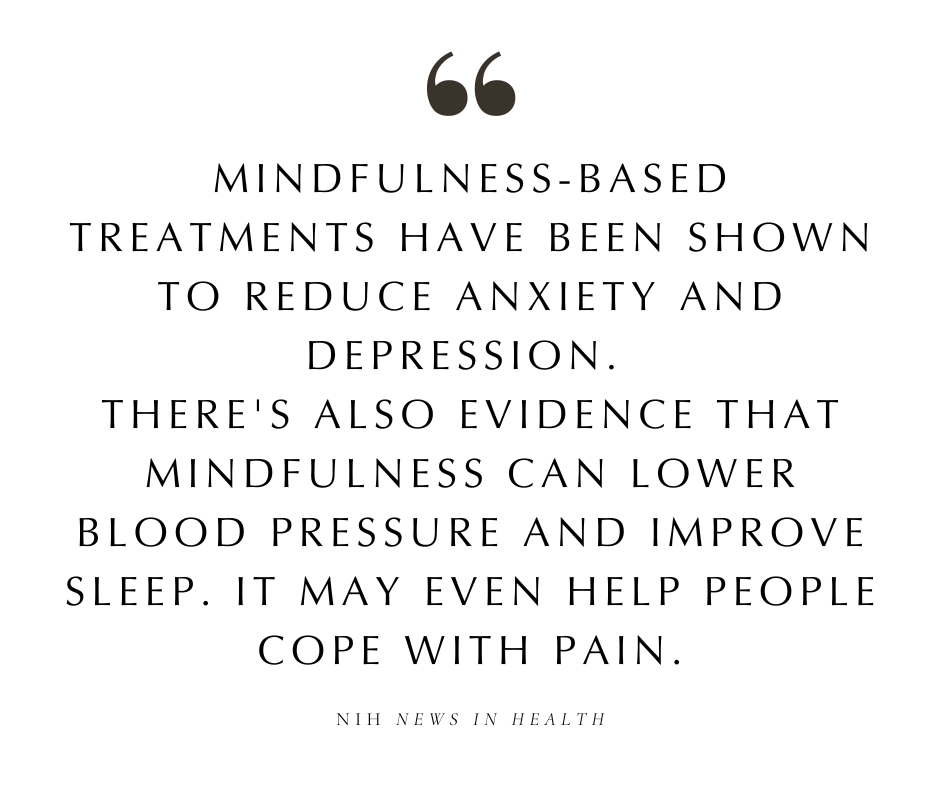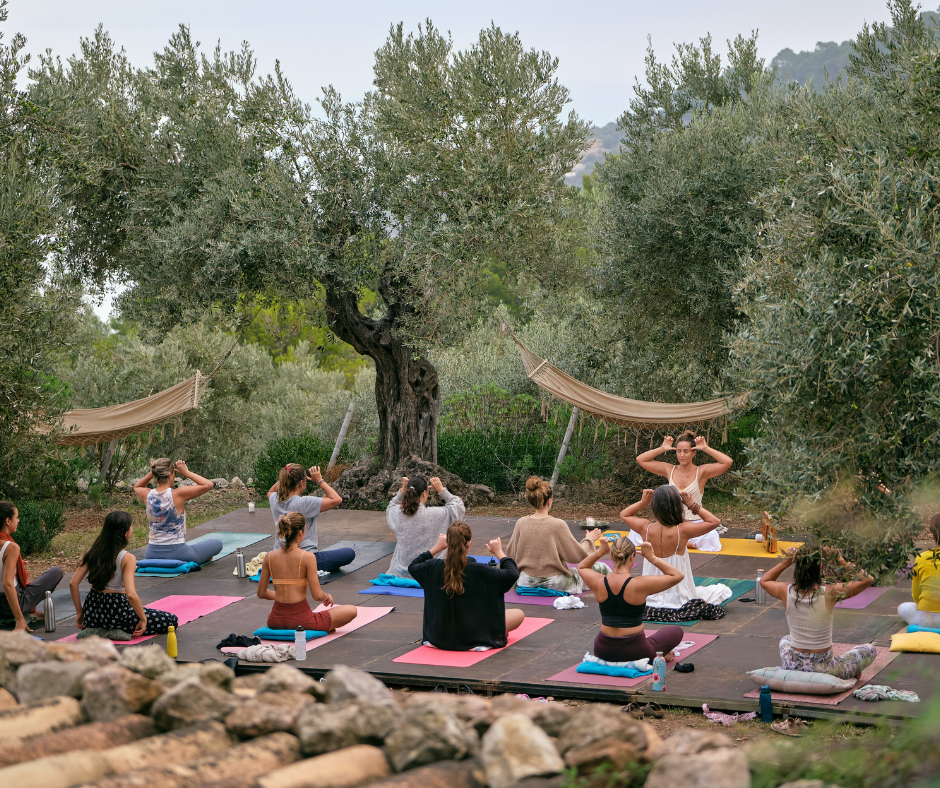

Mindfulness in the Workplace: How to Elevate Your Experience and Honor Others
Summary
Reflection Questions
Journal Prompt
In today’s dynamic and demanding work environments, the value of mindfulness cannot be overstated, particularly for women in creative fields who either run their own solo practices or lead teams. Taking mindful moments allow women to cultivate a sense of balance, clarity, and purpose amidst the hustle and bustle of their professional lives. Whether as independent ceramicists shaping their craft or as visionary architects guiding their teams, women in creative roles can harness mindfulness practices to enhance their decision-making, foster innovation, and nurture sustainable success. By incorporating mindfulness into their daily routines, women can embrace self-care, harness their creative potential, and cultivate thriving work cultures that prioritize well-being and collaboration, regardless of their specific roles or organizational structures. Let’s examine how we can all incorporate mindfulness at work.


TL;DR
We discuss the importance of mindfulness in the workplace, especially for women in creative fields. This article covers the rising trend of mindfulness training to improve mental health, productivity, and foster a positive work culture. The benefits of mindfulness at work include enhanced creativity, focus, reduced stress, and improved communication.
We also provides practical tips for solo entrepreneurs and team leaders on incorporating mindfulness into their daily routines and leadership practices, aiming to create more supportive and inclusive work environments.
Taking a Look at the Mindfulness Training Trend


Mindfulness training has become increasingly popular in recent years, both in our personal and professional lives. The workplace mindfulness trend reflects a growing recognition of the benefits of mindfulness practices for mental health, well-being, and productivity. By incorporating mindfulness prorgrams into employee wellness initiatives, organizations can support their employees in managing stress, enhancing resilience, improving focus and concentration, and fostering a positive work culture conducive to individual and organizational flourishing. Let’s take a closer look at how businesses are helping their leaders and employees develop mindfulness.
Increased Awareness and Acceptance
There’s a greater awareness and acceptance of mindfulness as a scientifically validated approach to enhancing mental health and performance. Research studies have demonstrated the effectiveness of mindfulness-based interventions in reducing stress, anxiety, depression, and improving overall psychological functioning.
Adoption of Mindfulness Exercises in Corporate Settings


Many companies and organizations are integrating a mindfulness practice into their employee wellness programs. This trend is driven by a desire to support employee well-being, enhance resilience, and foster a positive work culture in which mental health issues are no longer simply ignored. Mindfulness training initiatives often include workshops, seminars, and online courses aimed at teaching employees mindfulness techniques such as meditation, deep breathing, and body scans.
Mindfulness Based Stress Reduction
One of the primary goals of mindfulness training in the workplace is stress reduction and resilience building. By teaching employees how to cultivate mindfulness, organizations aim to help them better cope with the demands and pressures of their jobs. Mindfulness practices promote relaxation, emotional regulation, and cognitive flexibility, which are essential skills for managing stress and enhancing resilience.
Improved Focus and Concentration
Mindfulness training also aims to improve focus, concentration, and attentional control. In today’s fast-paced and constantly connected world, maintaining focus amidst distractions is a significant challenge. Mindfulness practices such as focused attention meditation help individuals train their minds to sustain attention on the present moment, leading to greater cognitive performance and productivity.
Enhanced Emotional Intelligence


Mindfulness training promotes the development of emotional intelligence (EI) by increasing self-awareness, self-regulation, empathy, and social skills. Employees who undergo mindfulness training are better equipped to recognize and manage their emotions, communicate effectively with others, and navigate interpersonal relationships with greater empathy and understanding. We’ll get into this a bit more in our section on the benefits of mindfulness.
Holistic Approach to Well-being
Mindfulness training takes a holistic approach to well-being by addressing the interconnectedness of mind, body, and spirit. In addition to mental health benefits, mindfulness practices have been associated with improvements in physical health, such as reduced blood pressure, improved immune function, and better sleep quality. By promoting holistic well-being, organizations can support employees in achieving greater overall health and vitality.
Fuel your creative fire & be a part of a supportive community that values how you love to live.
subscribe to our newsletter
*please check your Spam folder for the latest DesignDash Magazine issue immediately after subscription


Integration into Leadership Development
Mindfulness training is increasingly integrated into leadership development programs, recognizing the importance of mindful leadership in fostering employee engagement, innovation, and organizational success. A mindful leader will lead by example, embodying qualities such as presence, empathy, and authenticity. They create environments that prioritize psychological safety, collaboration, and continuous learning, thereby enabling their teams to thrive.
The Many Benefits of Mindfulness at Work
For women in creative fields, mindfulness not only enhances personal well-being but also amplifies their creative output, leadership abilities, and capacity to foster inclusive and supportive work environments. Incorporating mindfulness practices into daily routines can be a powerful tool for personal and professional development in these dynamic and often challenging fields. Let’s take a closer look at the benefits of mindfulness programs.
Enhanced Creativity


Mindfulness helps in fostering a state of mind conducive to creativity. It combats negative thoughts that might hinder creative thinking and self-expression, by focusing on the present. This mental state allows for freer thought and the generation of new ideas, which is vital in creative fields.
Improved Focus
Training in mindfulness meditation has been shown to enhance the ability to concentrate on a single task at a time, reducing the tendency for distraction. This focused mindset is beneficial across all activities, especially in creative work where sustained attention is required for innovation and problem-solving.
Reduced Stress and Anxiety
Mindfulness practices can shift individuals out of the fight-or-flight response, bringing them into a state of calm and mental clarity. This is particularly useful in high-pressure creative roles where stress and anxiety can stifle creativity and productivity.
Improved Communication


In the distraction-filled modern workplace, mindfulness helps in retraining focus on the present moment, enabling active listening and compassionate engagement with colleagues. This can lead to more meaningful interactions and collaborations, enhancing the creative process.
Leadership Development
Mindfulness plays a role in the development of high-potential leaders by increasing self-awareness. This is crucial for women in creative fields who often take on leadership roles, as it helps them navigate the challenges of guiding creative teams and projects with empathy and clarity.
Coping with Change
Creative fields are often subject to rapid change and uncertainty. Mindfulness can assist individuals in coping with these changes more effectively by reducing stress associated with loss of control and promoting adaptability and resilience.
Fostering Inclusive and Supportive Work Environments
Women leaders tend to prioritize the well-being of their employees and engage in diversity, equity, and inclusion initiatives. Mindfulness can support these efforts by building workplaces that are more respectful, engaged, and collaborative, which is especially beneficial in creative environments where diverse ideas and perspectives are valued.
Recent Mindfulness Research That Supports These Benefits


One significant study on mindfulness involved Gaelle Desbordes, who investigated its effects on depression using functional magnetic resonance imaging (fMRI). The study, which focused on mindfulness meditation’s impact on the brain, showed that changes in brain activity remained even when subjects were not meditating, particularly in the amygdala, a region associated with emotional processing.
This research, part of a broader effort at Harvard and its affiliated institutions, aims to understand how mindfulness can be beneficial, especially for conditions like depression, chronic pain, and anxiety, with mindfulness-based cognitive therapy (MBCT) being a key focus. Desbordes’ work, which includes comparisons with control groups undergoing different treatments, seeks to pinpoint the mechanisms by which mindfulness can aid in disengaging from negative thoughts and potentially serve as an effective therapy for depression and other conditions .
Key Traits to Cultivate As Part of Your Mindfulness Practice


Cultivating mindfulness at work involves developing a range of traits and skills that contribute to overall well-being and effectiveness in various professional settings. Fostering traits and skills such as emotional intelligence, self-awareness, resilience, growth mindset, focus, empathy, and compassion can greatly enhance mindfulness at work. By cultivating these qualities, women can navigate the demands of the workplace with greater ease, effectiveness, and well-being, ultimately contributing to a more positive and harmonious work environment. Read on to learn more about these key traits before you practice mindfulness.
Emotional Intelligence
Emotional intelligence (EI) is crucial for practicing mindfulness at work. It involves the ability to recognize, understand, and manage one’s own emotions, as well as the emotions of others. By developing EI, women can navigate interpersonal interactions with greater empathy and self-awareness. This allows them to respond to challenging situations calmly and constructively, fostering better relationships and a more positive work environment.
Self-Awareness


Self-awareness is fundamental to mindfulness. It involves being conscious of one’s thoughts, feelings, and behaviors in the present moment. By cultivating self-awareness, women can recognize their strengths, weaknesses, and triggers, enabling them to make more informed decisions and regulate their responses effectively. This heightened self-awareness also facilitates personal growth and development over time.
Resilience
Resilience is the ability to adapt and bounce back from setbacks, challenges, and adversity. In the fast-paced and often unpredictable workplace, resilience is essential for maintaining focus, productivity, and well-being. Mindful women are better equipped to cope with stress, uncertainty, and failure, as they approach difficulties with a sense of perspective and equanimity. They view setbacks as opportunities for learning and growth, rather than insurmountable obstacles.
Growth Mindset
A growth mindset is the belief that abilities and intelligence can be developed through dedication and effort. Embracing a growth mindset fosters a willingness to learn, take risks, and persist in the face of obstacles. Mindful women with a growth mindset are more open to feedback, seek out new challenges, and continuously strive for improvement. They view failures as valuable learning experiences and setbacks as temporary setbacks on the path to success.
Focus and Concentration


Mindfulness involves sustained attention and concentration on the present moment. Developing the ability to focus amidst distractions is crucial for productivity and effectiveness in the workplace. Mindful women practice techniques such as meditation and deep breathing to enhance their ability to stay focused and attentive to the task at hand. They prioritize their work based on importance and urgency, minimizing multitasking and maximizing productivity.
Empathy and Compassion
Empathy and compassion are essential qualities for fostering positive relationships and collaboration in the workplace. Mindful women cultivate empathy by actively listening to others, acknowledging their perspectives, and validating their experiences. They demonstrate compassion by offering support, encouragement, and understanding to colleagues in need. By fostering a culture of empathy and compassion, mindful workplaces promote mutual respect, trust, and camaraderie among team members.
Ways to Be More Mindful at Work
Being mindful in the workplace is essential for both individual productivity and team harmony, whether you’re a solo creative entrepreneur or leading a team. From developing a meditation practice to setting realistic expectations, let’s explore options tailored to each type of creative entrepreneur.
By incorporating your own mindfulness program into your daily routine or leadership approach, you can cultivate mindfulness in the workplace and create a more positive and productive environment for yourself and your team.
For the Solo Creative Entrepreneur
Set Intentions
Begin each workday by setting clear intentions, a practice that paves the way for purposeful and meaningful accomplishments. Reflecting on your goals and the impact you wish to create not only clarifies your objectives but also imbues your day with a sense of purpose. This focused clarity propels you forward, ensuring that every action is aligned with your broader vision, making your workday not just productive but deeply fulfilling.
Create Rituals


Establishing rituals that bookend your workday can significantly enhance your sense of well-being and productivity. Whether it’s the serene act of lighting a candle, the reflective practice of meditation, or the simple pleasure of a short walk, these rituals serve as signals to your brain, marking the beginning and end of your workday. Such practices not only demarcate your professional and personal time but also infuse your day with moments of peace and contemplation, grounding you in the present.
Practice Single-Tasking
Embrace the art of single-tasking by dedicating your full attention to one task at a time. In a world that often glorifies multitasking, choosing to fully engage with the task at hand—be it crafting pottery or managing finances—can be revolutionary. This approach not only enhances the quality of your work but also enriches your experience, turning each task into an opportunity for mindfulness and deep engagement.
Take Breaks
Integrating regular breaks into your schedule is crucial for sustaining energy and creativity throughout the day. These pauses are not merely moments to step away from your work but are opportunities to rejuvenate your mind and body. Whether through stretching, practicing deep breathing, or simply enjoying a moment of stillness, these breaks can significantly boost your productivity and creativity, ensuring you return to your work refreshed and revitalized.
Mindful Creation


Approach your creative endeavors with mindfulness, fully immersing yourself in the experience. Pay close attention to the sensations, thoughts, and emotions that emerge as you engage in your creative process. This practice not only enhances the quality of your work but also deepens your connection to it, transforming your creative activities into a source of joy and fulfillment.
Cultivate Gratitude
Make it a daily practice to recognize and appreciate the aspects of your life that you’re grateful for. Whether it’s gratitude for the opportunity to pursue your passions or for the support of those around you, acknowledging these elements can profoundly impact your well-being and perspective. This simple yet powerful mindful exercise can elevate your mood, foster positivity, and remind you of the abundance in your life, even in moments of challenge.
For the Team Leader
Lead by Example
@designdasher Multi-tasking is a myth! Get focused, because what you decide to do deserves your full attention. #multitasking #singletasking #productivity #designdash #designdasher ♬ original sound – DesignDash
Embrace the role of a trailblazer in your workspace by exemplifying mindful behavior. Show your team the transformative power of mindfulness by integrating it into your daily routines and decision-making processes. Whether it’s through taking mindful moments to breathe before meetings, demonstrating active listening, or managing tasks with calm focus, let your actions communicate the value of mindfulness. This approach not only enriches your leadership style but also inspires your team to embody similar practices, fostering an environment of heightened awareness and presence.
Encourage Open Communication


Cultivate an atmosphere where open communication flourishes. Champion a workspace where every voice is valued and heard, from sharing innovative ideas to voicing concerns. By establishing regular check-ins and fostering a non-judgmental space for dialogue, you encourage a culture of transparency and mutual respect. This practice not only enhances team cohesion but also empowers individuals to contribute their best, knowing they have the support and ear of their colleagues and leaders.
Provide Resources
Actively support your team’s mindfulness journey by providing access to resources and training. Invest in workshops, guided meditation sessions, or subscriptions to mindfulness apps to facilitate personal and professional growth. By offering these tools, you not only show your commitment to the well-being of your team but also equip them with the skills to navigate workplace challenges with resilience and clarity.
Set Realistic Expectations
Forge a path of success by setting achievable goals and deadlines. Acknowledge the fine balance between ambition and well-being by allowing flexibility in project timelines and encouraging a culture where quality trumps quantity. This approach mitigates stress and burnout, promoting a sustainable and productive work environment where individuals can thrive without feeling overwhelmed.
Promote Collaboration


Champion the spirit of teamwork by creating opportunities for collaborative efforts. Encourage the exchange of ideas and resources, and set up platforms where team members can co-create and support each other’s endeavors. Such an environment not only accelerates innovation but also strengthens interpersonal bonds, making the workplace a nurturing ground for collective success.
Celebrate Successes
Make recognition and appreciation a cornerstone of your leadership. Celebrate the milestones and achievements of your team with genuine acknowledgment and gratitude. Whether through public commendation, personal notes, or team gatherings, showing appreciation for hard work and success boosts morale, reinforces positive behavior, and cultivates a culture of excellence and mutual respect.
Final Thoughts on Mindfulness in the Workplace


In forging ahead with these guiding principles, you not only elevate your leadership but also sculpt a workspace that vibrates with creativity, resilience, and mutual respect. Leading by example, fostering open communication, providing mindful resources, setting realistic expectations, promoting collaboration, and celebrating successes are not just strategies; they are the hallmarks of a visionary leader.
By embracing these practices, you create an environment where every team member feels valued, engaged, and inspired to bring their best selves to the table. This is the essence of transformative leadership—cultivating a culture where mindfulness, appreciation, and collaboration drive innovation and success. In doing so, you not only achieve your organizational goals but also contribute to the well-being and growth of your team, setting a new standard for excellence in the workplace.
Let us know how you plan to be more mindful at work in the comments below.
Design Dash
Join us in designing a life you love.
-
Why Interior Designers Should Consider an Online Color Theory Class
Read on to learn more about this discipline and for a short list of our favorite online color theory classes to get you started.
-
How to Avoid Overpaying Estimated Taxes as a Firm Owner
Most firm owners must submit quarterly estimated tax payments based on their AGI. Here’s how to avoid overpaying estimated taxes as a design business owner.
-
Make It a Habit: The Key to Keeping New Year’s Resolutions
Behavioral scientists often argue that the key to the persistence and success of New Year’s resolutions lies in habit formation psychology.
-
Get to Know the DesignDash Team Through a Q&A at Our 2024 Holiday Party!
From favorite traditions to proudest moments, get to know the team and what inspires them for the new year by reading our 2024 holiday Q&A!
-
Your Digital Footprint: Why Entrepreneurs Need to Think Beyond Social Media
Social media is great for today, but creative entrepreneurs need a lasting online presence. Learn how to expand your digital footprint with websites, newsletters, and features that showcase your work for years to come.
-
Winter Capsule Wardrobe: Staying Stylish This Season with Just 10 Pieces
Simplify your mornings and elevate your style with our guide to creating a winter capsule wardrobe!








